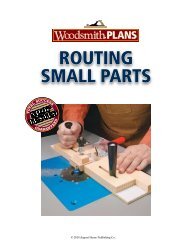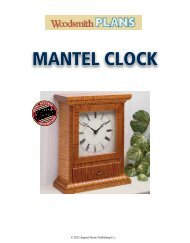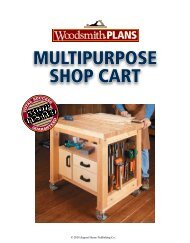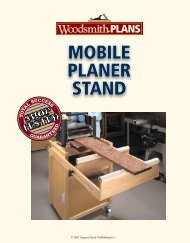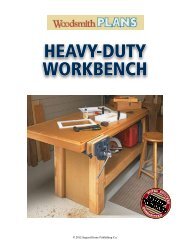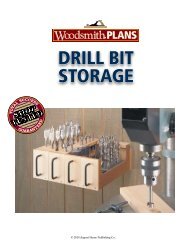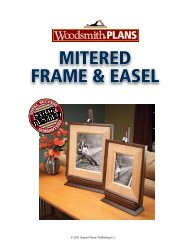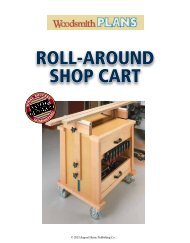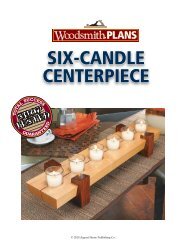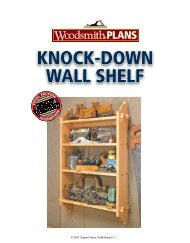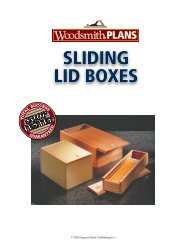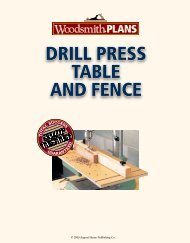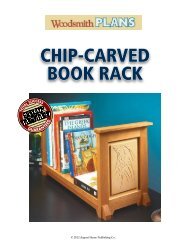Coffee Table Plan - Woodsmith Shop
Coffee Table Plan - Woodsmith Shop
Coffee Table Plan - Woodsmith Shop
- No tags were found...
You also want an ePaper? Increase the reach of your titles
YUMPU automatically turns print PDFs into web optimized ePapers that Google loves.
HEIRLOOMCOFFEETABLE© 2007 August Home Publishing Co.
<strong>Table</strong> TopWith the base complete, I set aboutto build the top. This is pretty simplereally. The top is just a glued-up mahoganypanel cut in an oval shape.To do this, I began by making apaper pattern first. Then I createda hardboard template from this patternand used the template as a guidewhen cutting and routing.PAPER PATTERN. As I mentioned, thefirst thing to do is create a pattern forthe top, see Fig. 7. The oval shapeof this table isn’t a true ellipse. Soit has to be drawn “freehand.” Thismay sound a bit intimidating, but itreally does require less artistic skillthan you might think. You just drawa grid, plot some points, and connectthe dots, see box below.There’s one more thing I wantto mention: You don’t even need tomake a full pattern; a quarter patternwill do. And it will give you more amore consistent template.HARDBOARD TEMPLATE. With the paperquarter pattern complete, I used it tomake a full-size template out of 1 / 4"-thick hardboard, see Fig. 8. Thereare a couple advantages to creating ahardboard template for this project.For one thing, if you happen to makea mistake when cutting or sanding thetemplate, it’s no big deal. Hardboardis cheap compared to mahogany.But even more important, it’s mucheasier to shape and sand a 1 / 4"-thick789TABLE TOP QUARTER PATTERNa.a.QUICK AND EASY GRIDI’m not an artist and don’t feel comfortabledrawing freehand curves.But recently, I was shown a quickway to draw freehand curves byfirst creating a rough grid. All youneed is some paper for the pattern,a pencil and a tape measure, and atable with a square corner.GRID. To do this, I made a 2" gridusing a trick I’d been taught by acarpenter, see left and center photos.To draw the lines, hold the tapefirmly with one hand and “hook”the pencil on the end of the tape.CONNECT DOTS. With the grid drawn,plot the points of the curve on thegrid. Now, drawing the curve is justa matter of “connecting the dots.”3 www.<strong>Woodsmith</strong>.com © 2007 August Home Publishing Co. All Rights Reserved.
hardboard template than a panel madefrom 3 / 4"-thick solid wood.Plus, I was able to use the templateto guide the router bit as I shaped theedge, refer to Figs. 10 and 11.To make the template, I started bycutting an oversize blank and drawingcenterlines on the top to create “crosshairs,” see Fig. 8. (The blank was 30"x 48".) Next, I drew the pattern on theblank, flipping it around the centerlinesfrom the quarter section until thelayout was complete, see Fig. 8a.When cutting out the hardboardtemplate, I used a jig saw with afine tooth blade, staying 1 / 16" fromthe layout line. Then I sanded thetemplate up to the line.OVERSIZE PANEL. Now that the templateis complete, the next step is toglue up a 3 / 4"-thick blank for the top.This blank starts out the same size asthe template blank (30" x 48").When the glue is dry, remove anyexcess glue and plane and sand thepanel flat. Then carpet tape the hardboardtemplate to the bottom face ofthe panel, see Fig. 9.Like the template, I rough cut thepanel with the jig saw. But this timeto get the panel flush with the template,I used a flush trim bit in therouter, see Figs. 10 and 10a.However, when routing the edgeof the table top, you’re likely to runinto some chipout. The solution is tobackrout the edge, see page 5.Next, I routed a profile along thetop edge of the table, see Figs. 11and 11a. (This requires the same1011procedure as the flush trim routing.)There are a number of profile bitsyou can use. I chose a special Freudbit (product no. 99-011) designedespecially for table top edges. Note:This bit didn’t fit the opening on myrouter base, so I replaced it with anauxiliary base, see Fig. 11.Once the profile was complete, Ihand sanded the bottom lightly toremove the sharp edge, see Fig. 11b.Before attaching the tabletop to thea.base, I applied the finish. First, I puta coat of stain on everything. (Formore on staining end grain, see page6.) Then I applied a couple coats ofvarnish. It’s a good idea to add a thirdcoat to the top. This way, there’s athicker film of finish so you can “rubout” the finish to a high gloss.When the finishing is done, the onething that’s left is to attach the tabletop to the base with Z-shaped fasteners,see drawing below. Wa.a.b.b.4 www.<strong>Woodsmith</strong>.com © 2007 August Home Publishing Co. All Rights Reserved.
Tips fromOur <strong>Shop</strong>Talking <strong>Shop</strong>BackroutingOne of the cardinal rules ofrouting is that you shouldalways move the router (orthe workpiece) so that thestock is fed into the cuttingedge of the bit. There’s agood reason for this.DIRECTION. When routingin the normal direction(moving the router left toright), you’re pushing thecutting edge of the bit intothe wood (or vice versa ona router table). This givesyou a lot more control overthe cutting action. As soonas you stop pushing, thebit stops cutting.If you rout in the oppositedirection (backrouting),the feed direction isthe same as the directionthe bit is rotating. So thebit pulls itself forward as itdigs into the workpiece.On a router table, this canbe disastrous. The routercan actually pull the workpiece(and your fingers)right into the router bit. Forthis reason, I avoid backroutingon a router table.Backrouting with ahand-held router is anotherstory. Since the workpieceis clamped down to abench, the bit tends topull the router forward(instead of the workpiece).This makes it difficult tocontrol the router, but youdon’t have to worry aboutyour fingers coming intocontact with the bit likeyou do on a router table.So even though it’sa little tricky, there aretimes when I backrout toget better results. Takethe top of the cof feetable, for example.END GRAIN. Because ofthe oval shape of the top,it’s impossible to avoidrouting across end grain.In this case, if you routaround the top in the normaldirection, you run therisk of ripping out largesplinters of wood as youpush the router bit pastthe end grain, see Fig. 1.But by backrouting thetop, the router bit pulls itselfinto the grain rather thanpushing against it, see Fig.2. So I was able to backroutaround the entire edge of thetop without any tearout.SAFETY. But even with ahand-held router, backroutingcan be risky. SoI usually take a few extrasafety precautions. First,I always maintain a firmgrip on the router in caseit kicks back. And I clampthe workpiece down to mybench so that it doesn’t shiftor go flying off.Start off by practicingon some scrap pieces ofwood to get a feel for howthe router reacts. At first,the router will feel like adog on a leash that’s justspotted a cat. It will have atendency to kick back fromthe workpiece and to skidalong the edge.But keeping your elbowstucked into your bodyand your arms and wristslocked in place should giveyou a little more control.Finally, I take severalvery light cuts when backroutinginstead of trying tomake the cut in a singledeep pass. Then, after I’veremoved all the material, Imake a final pass with therouter in the normal direction.This removes anychatter marks left behindby the backrouting. W1 25 www.<strong>Woodsmith</strong>.com © 2007 August Home Publishing Co. All Rights Reserved.
WoodworkingTechniqueStaining End GrainWhen finishing a project, end grain can create some unique problems.Here are some quick solutions we’ve come up with in our shop.There’s one finishing problem thatdoesn’t get a whole a lot of attention:end grain. Often after staining,the end grain will look much darkerthan the face grain.Maybe the reason why this problemdoesn’t get much attention is thatwoodworkers have just learned to “livewith it.” Still, there are a few steps youcan take that will prevent this fromhappening. But it helps to know whyit happens in the first place.OPEN PORES. End grain naturallylooks a little different than face grain.But it also acts differently too. Thereason for this is simple. The endof a board is made up of open poresthat work like a bunch of straws.Whatever is put on the surface of theboard won’t penetrate very quickly.But any liquid substance (like glue orstain) applied to the open ends will bepulled deep into the wood.STAINING END GRAIN. Applying a staincreates a real problem for end grain.Again, the open pores suck up thestain like a kid at a soda fountain.But that’s only part of the explanation;after all, end grain sucks upclear finishes just as deep as stains.{ A gel stain is just a thick stain. Its thicknesslimits the amount it penetrates, so I usuallywork it into the pores with a brush.What makes the stain different is thatit isn’t clear. And the deeper the staingets pulled into the wood, the darkerthe color at the surface will be. Theresult is ends that are noticeablydarker than the face of a piece.Getting the end grain to match therest of the project is a matter of stoppingthe stain from penetrating sodeep. That way, the end grain and facegrain end up with roughly the same{ After it’s wiped off, you can see that the limitedpenetration of a gel stain means the endgrain is the same color as the face grain.amount of stain. Fortunately, thereare a number of ways to do this.GEL STAINSWhen you’re staining a project witha lot of exposed end grain, the easiestway to get a consistent color is touse a gel stain. A gel stain is like anyother stain — it’s just a little thicker.So instead of spilling over the surfaceof a workpiece, a gel stain will just sitthere, like a glob of pudding.LIMITED PENETRATION. Because a gelstain is thick, it won’t penetrate verydeep into the wood, whether it’s facegrain or end grain, see photos at left.The result is that the end grain andthe face grain end up with an even,consistent color.You might think that gel stains areall alike; a magical formula that anexpert concocted. Although all gelstains are definitely thicker than regularliquid stains, they’re not all thesame. When it comes to end grain, thebiggest difference is their thickness.6 www.<strong>Woodsmith</strong>.com © 2007 August Home Publishing Co. All Rights Reserved.
I’ve used some stains that were theconsistency of thick cream. Otherswere like a thick paste.Remember, what you want is astain that’s not going to seep into theend grain. So when choosing a gelstain, just keep in mind that a thickstain will tend to penetrate less andgive you a more even color.DRAWBACKS. Of course, gel stainsaren’t the answer in every situation.There are times when I want thestain to penetrate as deep as possible.When I have a piece of figured wood,like bird’s eye maple, I’m not goingto use a gel stain because I want tohighlight the figure of the wood. Thegel stain isn’t necessarily going to“hide” the grain. But it will even outthe color more than I want it to.The other time I don’t use a gelstain is when I can’t find the exactcolor I want. Here, I usually end upchoosing a traditional (liquid) oil orwater-base stain, so I take a differenttack to handle the end grain.LIQUID STAINSWhen I work with a traditional liquidstain, I usually get a more even colorif I do a little extra sanding on the endgrain — to 600 grit instead of 220, seephotos above. The reason this worksis because you’re burnishing the endgrain. The pore openings are beingpolished so they’re smaller and don’tsoak in as much stain.CURVED SURFACES. With the coffee{ When staining end grain, a regular stain willsoak deep into the pores of the wood, darkeningthe ends much more than the face.table, the stain with the color I likedhappened to be a traditional oil-basestain. The problem was the table wascurved. In fact, this table threw memore than one curve.For one thing, the cabriole legshave end grain at the top of the kneesand the feet. But there’s no “hard”corner where the end grain startsand the edge grain stops. So insteadof sanding finer, I’d recommendusing wood conditioner, see below.But the oval top was a differentmatter. Wood conditioner applied tothis narrow edge would seep into theface grain. I didn’t want light streaksaround the edge of the table, so Iwent back to the sanding solution andsanded the whole edge to 600-grit.TOP COATSWhen it’s time to apply a top coat, endgrain isn’t nearly as much of a problem.{ One solution to evening out the end grain is tosand it finer than the rest of the board. Here,I sanded the end grain to 600-grit.The finish penetrates just as deep,and in fact, you may notice that theend grain gets slightly darker. That’sbecause oil and varnish tend to addan amber tint to the wood anyway.But I’ve never thought this was verynoticeable, so I haven’t gone to thetrouble of sanding it any finer.About the only thing you will noticeabout putting a clear finish on endgrain is that it dries out a lot quicker.So I sometimes end up applying anextra coat of finish.One final note: I’ve talked to woodworkerswho sand all end grain to600 grit, even if they’re just applyinga clear finish with no stain. They dothis because the end grain looks andfeels so much better after it’s beensanded so fine. But I think this is a lotof unnecessary work. After you buildup a film of finish on the wood, youwon’t be able to tell a difference. WWOOD CONDITIONERWhat can be a little confusing aboutend grain is that it isn’t just limitedto the ends of a board. It can showup on the face of some boards, too.This is especially true of woodslike pine, cherry, and maple thattend to have wild, wavy grain.When the grain turns up towardthe face of a board, you end up witha small patch of end grain.When staining, these areas of endgrain can end up as dark blotches,see the left half of the board above.But you can avoid this.One solution I often use is to applya wood conditioner (or wash coat)before staining. This is usually justa solvent that evaporates slowly(although it can also be a very thinfinish). Because the conditioneris applied underneath the stain,it limits and evens out the stain’spenetration, see the right half ofthe board above.When staining the cabriole legs,one way to ensure an even coloris to brush a heavy coat of woodconditioner on the entire leg. Afterletting it set a few minutes, wipe offany excess and apply the stain.7 www.<strong>Woodsmith</strong>.com © 2007 August Home Publishing Co. All Rights Reserved.
WoodworkingTechniqueCabriole LegsCabriole legs may looklike sculpture, but youdon’t need to be anartist to make them.Cabriole legs look more like sculpturethan woodworking. And whilesome designs can get fancy, I keptthese cabriole legs pretty basic. Allyou need to do is follow the steps.TURNING BLANKS. Cabriole legs startout as thick, square blanks. To avoidjoint lines, I used solid stock to makethe legs. The problem is finding stockthat’s thick enough.To get blanks this size, I use 3" x3" turning squares. (You can orderthem from many woodworking catalogs.)I buy them extra long, so I canalso cut the transition blocks fromthe blank. Turning squares oftencome rough cut, so you may need tosquare them up before you can beginshaping the cabriole legs.MAKING PATTERNS. Once you havesquare turning blanks, the next step isto create templates for the leg. (I mademine out of 1 / 8" hardboard.) Thereare two templates that you’ll need tomake: one for the leg and another forthe inside faces of the transition blocks(added later). You can use the patternsshown below to create the templates.a.1Position the template so the backedge of the corner post alignswith inside corner of blank. Flip templateand repeat on adjacent side.2Next, use a square to drawreference lines around all fourfaces of the blank to indicate wherethe corner post meets the knee.3Cut the mortises on the twofaces with the patterns. Drilla series of overlapping holes, andclean up the cheeks with a chisel.4Set up band saw to make theface cuts on the corner post.Use a fence to guide the leg andclamp a stop block to the fence.8 www.<strong>Woodsmith</strong>.com © 2007 August Home Publishing Co. All Rights Reserved.
Or you can save some time and orderpre-made cabriole legs from thesources listed in the right margin.CORNER POST. After the shape of thelegs are laid out, it’s time to work onthe blank. I start with the corner postat the top, back edge of the leg.TRANSITION BLOCKS. While workingon the corner post, you’ll have to addtwo, rectangular transition blocks, seedrawing at right. These blocks areglued on over the knees of the legs.They should also line up with the referencelines between the corner postand the knee so they end up square.CUTTING THE LEGS. After the transitionblocks are in place and the cornerpost is completed, it’s time to cut theleg out. This is done in two steps.First, all the cuts are made alongone face of the leg. Since these cutsremove part of the pattern on theadjacent face, you need to save thewaste pieces. Then you simply tapethem back onto the blank and cut thecurves on the adjacent face.Now, while the leg is still relativelysquare, I sand the faces with a drumsander on the drill press. (You’ll needan auxiliary table to do this.)5Redraw the knee on the outerfaces of the transition blocks. Thereference line on the pattern shouldalign with the transition block.6< Align transition blocks on referencelines and carefully glue themin place. These blocks should beflush with the front faces of the leg.A second pattern is used to tracea profile on the inner faces of thetransition blocks. Place this pattern inthe corner and mark the outline.SOURCESAdams Wood Products423-587-2942adamswoodproducts.comWoodcraft800-225-1153woodcraft.comWoodworker’s Supply800-645-9292woodworker.com7 8 9Start sawing at the corner postby aligning blade with top oftransition block. Saw to the kerf. Thenrepeat the cut on the adjacent face.To cut the front face of the leg,start at the knee and saw aroundto the foot in one smooth pass. Besure to save the waste piece.Cut the back of the leg justlike the front. A second cut isneeded to form the transition block.Again, save the waste pieces.10The waste pieces are neededwhen cutting the remainingfaces of the leg blank. Tape the piecesto the blank in their original position.11 12Now, finish roughing out theleg by repeating the cuts onthe front and back faces. Again,work from the knee to the foot.At this point, the "square" legscan be sanded with a drumsander. But a larger auxiliary table willneed to be added to the drill press.9 www.<strong>Woodsmith</strong>.com © 2007 August Home Publishing Co. All Rights Reserved.
Shaping the LegAt this point, the blanks have beenroughed out, so they’re beginning tolook like cabriole legs. But all theedges are still square. So now,it’s time to do the final shapingthat will soften these edgesand give the cabriole legs theirgraceful appearance.SEQUENCE. To shape the legs,I worked from the bottomup, starting with the foot andmoving up to the transitionblocks at the knee.FEET. One of the tricks to makingcabriole legs is to get fourlegs that look similar. And the feetare probably the most noticeable.So I shaped the feet on all four legsand then set them side by side tocompare them. If one was noticeablysmaller, I worked on getting theothers to match it. But don’t be toocritical. After all, when the project’sbuilt, no one will be able to comparethem as closely as you can now.The first step for each foot is to layout the final radius on the top. Then thesquare corners can be sawed off.To do the shaping, I used a raspand a half-round file. Therasp allows you to removethe wood quickly. But thefile gives you a cleaner cut.13To begin shaping the legs,make a template to outlinethe foot. This is a piece of !/8" hardboardwith a 1!/8"-radius cutout.15Then, find the centerpointon the bottom of the leg,and use a compass to draw a circleon the bottom of the foot.14Now that the template hasbeen made, the top of thefoot can be laid out. Set the templateon the foot and trace the outline.16Next, hold the leg uprightand cut away the front andside corners of the foot with ahand saw held at a slight angle.a. a.17Still holding the leg upright,file the top face of the foot.Remove the sharp line and featherit out across the top.18Clamp the leg in a vise andshape the front and sidesof the foot, working from top tobottom to prevent chipout.19Next, shape the back of theheel by blending the radiuson the bottom of the foot intothe back of the ankle.11 <strong>Woodsmith</strong> No. ???10 www.<strong>Woodsmith</strong>.com © 2007 August Home Publishing Co. All Rights Reserved.
Both have a curved edge for cleaningup the top of the foot and a flat edgefor shaping the sides of the foot.LEGS. Once the feet were done, Istarted on the legs. There’s not muchto them. The front and back cornersof the legs get a small, tapered roundoverwith a file and some sandpaper.But these roundovers aren’t the samefor the front and back. The front getsrounded over a little more, see Steps20 and 22. The side corners are justsoftened with sandpaper.Shaping the legs is no trouble.The problem is holding themsteady while you work. And youneed some freedom to rotate theleg and work from different angles.So I came up with a shop-madecarver’s cradle by adding woodenextenders to the jaws of a common3/ 4" pipe clamp, see page 12.KNEES. The last area of the leg to workon is the knee, including the transitionblock. There’s not much shaping todo. It’s mostly just cleanup.To begin, I removed the ridgebetween the corner post and the kneewith a sharp chisel. But here, you haveto work carefully. A slip with the chiselcan put a scratch in the corner postwhich will be a chore to remove.Next, I dry assembled the apronsand marked the location of their outsidefaces. Then I rounded over thetop of the transition block with sandpaper,removing the hard edge.All that’s left is to sand the leg toget it ready for the finish. If you’regoing to use stain, the trick is to geta consistent color. To do this, I useda wood conditioner. W20Lay out marks to show thetapered roundover on thefront corner. Connect them withlines up and down the leg.Now with a file and sandpaper,round over the front21edge of the leg, following the layoutlines that were just drawn.22The back edge also getsa tapered roundover (notas much as the front). Also, lightlysand both side edges of the leg.23Between the corner postand the beginning ofthe knee, there may be a smallridge. This can be carefully paredaway with a chisel.24Set the aprons in placeand trace the frontedges. Remove the aprons andround over the hard edge to theline using a chisel.25Finally, sand the leg to220 grit. If you’re applyinga liquid stain, you might wantto use a wood conditioner beforestaining the workpiece.FACTORY-MADE CABRIOLE LEGSIf you want to build the projects inthis issue without making the cabriolelegs, we designed the projects soyou can buy factory-made legs.Of course, the design of these legsisn’t exactly like ours. The critical differenceis that the transition blocksare a bit different. This means you’llneed to make some adjustmentsin the profiles of the aprons thatconnect the legs so the transitionbetween the two is smooth.Which brings up another difference.With factory-made legs, youneed to drill the mortises with the legalready shaped. But the curves get inthe way, so you’ll have to use a specialspacer block, see page 12.12 <strong>Woodsmith</strong> No. ???11 www.<strong>Woodsmith</strong>.com © 2007 August Home Publishing Co. All Rights Reserved.
Tips FromOur <strong>Shop</strong><strong>Shop</strong> NotesLeg Clamping JigAfter cutting out cabriolelegs, they still need to befiled and sanded to theirfinal shape. To do this, Ineeded a way to hold theleg steady, yet leave plentyof room to work around it.I solved this problem witha special clamping jig.This jig resemblesa carver’s “cradle” with aheadstock and tailstockattached to the pipe clamp.Its pieces are constructedfrom 2x4 stock with a holebored through each piecefor the pipe, see Fig. 1.To keep the tailstockfrom swiveling, I cut a kerfpart way through it on thebandsaw, see Fig. 2. Then Iadded a carriage bolt andwing nut. Once the jaw isset where you need it, justtighten the wing nut to keepthe tailstock from turning.Keeping the headstockfrom moving is a littleeasier. Just cut a notch inone edge the same size asthe jaw of the clamp.As the clamp is tightened,both the headstock andtailstock tend to tilt back.To compensate for this, Iplaned a slight taper on theinside edge of each piece.Finally, I added a piece ofself-adhesive sandpaperto the inside face of thejaws. It gives them a bettergrip on the leg.1 2Mortising Pre-made Cabriole LegsOne option that makes thecoffee table easier to build isto purchase the legs insteadof making them, see photo.But even pre-made legswill need mortises drilledin the corner post to holdthe stretchers and rails.The problem with drillingthe mortises is theonly thing square on theleg is the corner post. Andwhen the leg is set down onthe drill press, the curvededges get in the way. So tokeep the leg square, I madea spacer block to set it on.This spacer is madefrom two pieces of 1 1 / 2"-thick stock glued togetherto form an L-shapedblock. It holds the cabrioleleg up off the tableand out from the fence.This way, the blockkeeps the face of the cornerpost square to the bit.It also helps to keep theleg and the fence alignedso the mortises are drilledin a straight line as thewaste is removed.12 www.<strong>Woodsmith</strong>.com © 2007 August Home Publishing Co. All Rights Reserved.



